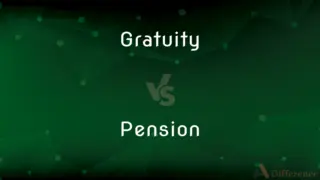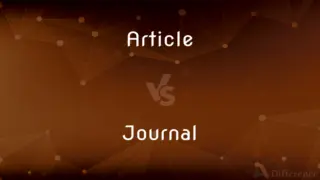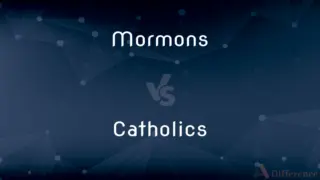Categorize vs. Classify — What's the Difference?
By Maham Liaqat & Urooj Arif — Updated on March 19, 2024
Categorizing involves grouping items based on shared characteristics, while classifying orders these groups into a structured system based on their relationships.

Difference Between Categorize and Classify
Table of Contents
ADVERTISEMENT
Key Differences
Categorizing is the process of grouping items or information based on common characteristics or themes, making it easier to manage and understand large sets of data. Classifying, on the other hand, goes a step further by not only grouping but also organizing these categories into a hierarchical system that shows their relationships and relative ranks.
While categorization can be seen as a more general and initial step in organizing information, classification is more detailed and structured. Classification often involves predefined criteria and rules that dictate how the categories are organized within a larger system.
In practice, categorizing might involve grouping animals based on their habitat or diet, such as terrestrial and aquatic animals, or herbivores and carnivores. Classifying these animals, however, could involve placing them into a detailed taxonomic hierarchy based on their evolutionary relationships, such as kingdom, phylum, class, order, family, genus, and species.
The purpose of categorization is to simplify and bring order to complex sets of data by identifying similarities among items, making it easier to find, compare, or analyze them. Classification, while it also seeks to bring order, does so with the goal of understanding and elucidating the relationships and hierarchies among the categories, providing a more in-depth analysis of the data.
Categorization and classification are both crucial in various fields such as biology, library science, and information technology, each serving its purpose in organizing and understanding information. While categorization might be sufficient for basic organization and retrieval tasks, classification is necessary for tasks that require understanding the nuanced relationships and structures within the data.
ADVERTISEMENT
Comparison Chart
Definition
Grouping items based on shared characteristics.
Ordering groups into a structured system based on relationships.
Purpose
Simplify and organize data for easy understanding.
Understand and elucidate relationships and hierarchies among categories.
Detail
More general and broad.
More detailed and structured.
Example
Grouping animals as terrestrial or aquatic.
Placing animals into a taxonomic hierarchy (kingdom, phylum, etc.).
Application
Initial step in organizing information.
Detailed analysis and understanding of the data's structure.
Compare with Definitions
Categorize
Simplifies complex sets of data for easier management.
Categorizing expenses by type helped them better understand their spending patterns.
Classify
Involves predefined criteria and rules for organization.
Libraries classify books according to the Dewey Decimal System for systematic arrangement and retrieval.
Categorize
Grouping items or information based on common characteristics.
She categorized the books on her shelf by genre to find them more easily.
Classify
Aims to elucidate relationships and hierarchies among categories.
In her thesis, she classified the types of social networks to analyze their impact on communication.
Categorize
Can be applied flexibly based on needs or context.
The teacher categorized the students' questions into themes to address them more efficiently.
Classify
Organizing groups into a hierarchical system showing relationships.
Scientists classify living organisms into a detailed taxonomic hierarchy to understand their evolutionary relationships.
Categorize
A broad and initial step in data organization.
For his research, he began by categorizing the data into qualitative and quantitative types.
Classify
Requires a detailed analysis and understanding of the data.
The software classified the responses into various sentiment categories based on their content and tone.
Categorize
Focuses on identifying similarities among items.
The museum categorized the artifacts by their cultural origin to design the exhibit.
Classify
Used in tasks that need an in-depth understanding of structure.
To better manage the database, they classified the information based on access levels and sensitivity.
Categorize
Place in a particular class or group
Silk is categorized as a luxury import
Classify
To arrange or organize according to class or category.
Categorize
To put into a category or categories; classify.
Classify
To designate (a document, for example) as confidential, secret, or top secret.
Categorize
(transitive) To assign a category; to divide into classes.
First, categorize incoming messages according to the needed actions.
Classify
To identify by or divide into classes; to categorize
Should we classify "make up" as an idiom or as a phrasal verb?
Categorize
To insert in a category or list; to class; to catalogue.
Classify
To declare something a secret, especially a government secret
They decided to classify that information.
Categorize
Place into or assign to a category;
Children learn early on to categorize
Classify
To make classy
Classify
To distribute into classes; to arrange according to a system; to arrange in sets according to some method founded on common properties or characters.
Classify
Arrange or order by classes or categories;
How would you classify these pottery shards--are they prehistoric?
Classify
Declare unavailable, as for security reasons;
Classify these documents
Classify
Assign to a class or kind;
How should algae be classified?
People argue about how to relegate certain mushrooms
Common Curiosities
What does it mean to categorize something?
Categorizing involves grouping items or information based on shared characteristics to simplify and organize data.
Can you give an example of classifying?
An example of classifying is placing animals into a taxonomic hierarchy like kingdom, phylum, class, order, family, genus, and species.
What is the purpose of classification?
The purpose of classification is to elucidate the relationships and hierarchies among categories, providing a detailed analysis of the data.
Can you give an example of categorizing?
An example of categorizing is grouping animals as either terrestrial or aquatic based on their habitat.
How do businesses use categorization and classification?
Businesses use categorization to group products or services for marketing and classification to organize data for analysis, decision-making, and strategy development.
Can categorization and classification be applied to digital data?
Yes, both can be applied to digital data for organizing, managing, and analyzing information in fields like data science and information technology.
Can the terms categorize and classify be used interchangeably?
While related, the terms cannot be used interchangeably because they involve different levels of data organization and serve different purposes.
What role does categorization play in everyday life?
In everyday life, categorization helps in organizing information and items, such as sorting emails or groceries, for efficiency and ease of access.
What does it mean to classify something?
Classifying means organizing groups into a structured system that reflects their relationships and hierarchies.
How are categorizing and classifying different?
Categorizing is a broad, initial step in organizing data by similarities, while classifying involves a more detailed organization into a hierarchical structure based on relationships.
How does classification help in science?
In science, classification helps in understanding evolutionary relationships, predicting characteristics, and organizing biological diversity in a systematic manner.
What skills are necessary for effective categorization and classification?
Skills necessary include analytical thinking, understanding of the data or items being organized, and knowledge of the principles and systems of classification.
Why is categorization important?
Categorization is important for simplifying complex data sets, making them easier to manage, find, compare, or analyze.
Is classifying more detailed than categorizing?
Yes, classifying is more detailed than categorizing, as it involves organizing data into a structured hierarchical system based on specific criteria and relationships.
What is an example of a classification system?
The Dewey Decimal System, used in libraries to organize books, is an example of a classification system.
Share Your Discovery

Previous Comparison
Turbojet vs. Turbofan
Next Comparison
Tall vs. BigAuthor Spotlight
Written by
Maham LiaqatCo-written by
Urooj ArifUrooj is a skilled content writer at Ask Difference, known for her exceptional ability to simplify complex topics into engaging and informative content. With a passion for research and a flair for clear, concise writing, she consistently delivers articles that resonate with our diverse audience.















































